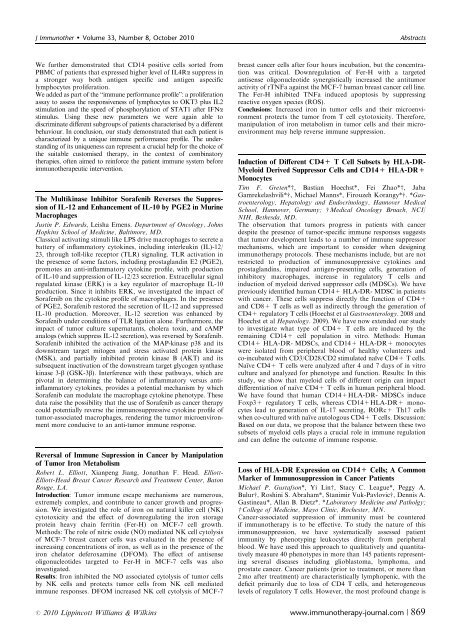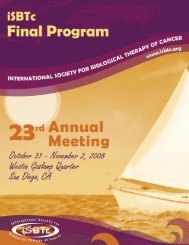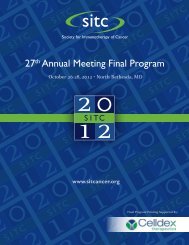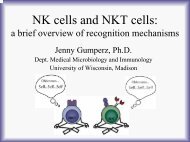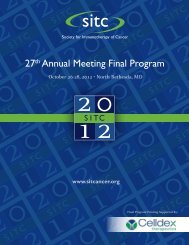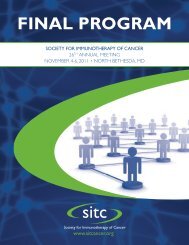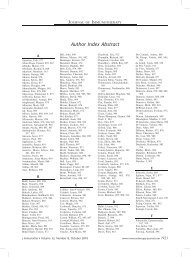Abstracts for the 25th Annual Scientific Meeting of the International ...
Abstracts for the 25th Annual Scientific Meeting of the International ...
Abstracts for the 25th Annual Scientific Meeting of the International ...
Create successful ePaper yourself
Turn your PDF publications into a flip-book with our unique Google optimized e-Paper software.
J Immuno<strong>the</strong>r Volume 33, Number 8, October 2010<br />
<strong>Abstracts</strong><br />
We fur<strong>the</strong>r demonstrated that CD14 positive cells sorted from<br />
PBMC <strong>of</strong> patients that expressed higher level <strong>of</strong> IL4Ra suppress in<br />
a stronger way both antigen specific and antigen aspecific<br />
lymphocytes proliferation.<br />
We added as part <strong>of</strong> <strong>the</strong> ‘‘immune per<strong>for</strong>mance pr<strong>of</strong>ile’’: a proliferation<br />
assay to assess <strong>the</strong> responsiveness <strong>of</strong> lymphocytes to OKT3 plus IL2<br />
stimulation and <strong>the</strong> speed <strong>of</strong> phosphorylation <strong>of</strong> STAT1 after IFNa<br />
stimulus. Using <strong>the</strong>se new parameters we were again able to<br />
discriminate different subgroups <strong>of</strong> patients characterised by a different<br />
behaviour. In conclusion, our study demonstrated that each patient is<br />
characterized by a unique immune per<strong>for</strong>mance pr<strong>of</strong>ile. The understanding<br />
<strong>of</strong> its uniqueness can represent a crucial help <strong>for</strong> <strong>the</strong> choice <strong>of</strong><br />
<strong>the</strong> suitable customised <strong>the</strong>rapy, in <strong>the</strong> context <strong>of</strong> combinatory<br />
<strong>the</strong>rapies, <strong>of</strong>ten aimed to rein<strong>for</strong>ce <strong>the</strong> patient immune system be<strong>for</strong>e<br />
immuno<strong>the</strong>rapeutic intervention.<br />
The Multikinase Inhibitor Sorafenib Reverses <strong>the</strong> Suppression<br />
<strong>of</strong> IL-12 and Enhancement <strong>of</strong> IL-10 by PGE2 in Murine<br />
Macrophages<br />
Justin P. Edwards, Leisha Emens. Department <strong>of</strong> Oncology, Johns<br />
Hopkins School <strong>of</strong> Medicine, Baltimore, MD.<br />
Classical activating stimuli like LPS drive macrophages to secrete a<br />
battery <strong>of</strong> inflammatory cytokines, including interleukin (IL)-12/<br />
23, through toll-like receptor (TLR) signaling. TLR activation in<br />
<strong>the</strong> presence <strong>of</strong> some factors, including prostaglandin E2 (PGE2),<br />
promotes an anti-inflammatory cytokine pr<strong>of</strong>ile, with production<br />
<strong>of</strong> IL-10 and suppression <strong>of</strong> IL-12/23 secretion. Extracellular signal<br />
regulated kinase (ERK) is a key regulator <strong>of</strong> macrophage IL-10<br />
production. Since it inhibits ERK, we investigated <strong>the</strong> impact <strong>of</strong><br />
Sorafenib on <strong>the</strong> cytokine pr<strong>of</strong>ile <strong>of</strong> macrophages. In <strong>the</strong> presence<br />
<strong>of</strong> PGE2, Sorafenib restored <strong>the</strong> secretion <strong>of</strong> IL-12 and suppressed<br />
IL-10 production. Moreover, IL-12 secretion was enhanced by<br />
Sorafenib under conditions <strong>of</strong> TLR ligation alone. Fur<strong>the</strong>rmore, <strong>the</strong><br />
impact <strong>of</strong> tumor culture supernatants, cholera toxin, and cAMP<br />
analogs (which suppress IL-12 secretion), was reversed by Sorafenib.<br />
Sorafenib inhibited <strong>the</strong> activation <strong>of</strong> <strong>the</strong> MAP-kinase p38 and its<br />
downstream target mitogen and stress activated protein kinase<br />
(MSK), and partially inhibited protein kinase B (AKT) and its<br />
subsequent inactivation <strong>of</strong> <strong>the</strong> downstream target glycogen synthase<br />
kinase 3-b (GSK-3b). Interference with <strong>the</strong>se pathways, which are<br />
pivotal in determining <strong>the</strong> balance <strong>of</strong> inflammatory versus antiinflammatory<br />
cytokines, provides a potential mechanism by which<br />
Sorafenib can modulate <strong>the</strong> macrophage cytokine phenotype. These<br />
data raise <strong>the</strong> possibility that <strong>the</strong> use <strong>of</strong> Sorafenib as cancer <strong>the</strong>rapy<br />
could potentially reverse <strong>the</strong> immunosuppressive cytokine pr<strong>of</strong>ile <strong>of</strong><br />
tumor-associated macrophages, rendering <strong>the</strong> tumor microenvironment<br />
more conducive to an anti-tumor immune response.<br />
Reversal <strong>of</strong> Immune Supression in Cancer by Manipulation<br />
<strong>of</strong> Tumor Iron Metabolism<br />
Robert L. Elliott, Xianpeng Jiang, Jonathan F. Head. Elliott-<br />
Elliott-Head Breast Cancer Research and Treatment Center, Baton<br />
Rouge, LA.<br />
Introduction: Tumor immune escape mechanisms are numerous,<br />
extremely complex, and contribute to cancer growth and progression.<br />
We investigated <strong>the</strong> role <strong>of</strong> iron on natural killer cell (NK)<br />
cytotoxicity and <strong>the</strong> effect <strong>of</strong> downregulating <strong>the</strong> iron storage<br />
protein heavy chain ferritin (Fer-H) on MCF-7 cell growth.<br />
Methods: The role <strong>of</strong> nitric oxide (NO) mediated NK cell cytolysis<br />
<strong>of</strong> MCF-7 breast cancer cells was evaluated in <strong>the</strong> presence <strong>of</strong><br />
increasing concentrations <strong>of</strong> iron, as well as in <strong>the</strong> presence <strong>of</strong> <strong>the</strong><br />
iron chelator deferoxamine (DFOM). The effect <strong>of</strong> antisense<br />
oligonucleotides targeted to Fer-H in MCF-7 cells was also<br />
investigated.<br />
Results: Iron inhibited <strong>the</strong> NO associated cytolysis <strong>of</strong> tumor cells<br />
by NK cells and protects tumor cells from NK cell mediated<br />
immune responses. DFOM increased NK cell cytolysis <strong>of</strong> MCF-7<br />
breast cancer cells after four hours incubation, but <strong>the</strong> concentration<br />
was critical. Downregulation <strong>of</strong> Fer-H with a targeted<br />
antisense oligonucleotide synergistically increased <strong>the</strong> antitumor<br />
activity <strong>of</strong> rTNFa against <strong>the</strong> MCF-7 human breast cancer cell line.<br />
The Fer-H inhibited TNFa induced apoptosis by suppressing<br />
reactive oxygen species (ROS).<br />
Conclusions: Increased iron in tumor cells and <strong>the</strong>ir microenvironment<br />
protects <strong>the</strong> tumor from T cell cytotoxicity. There<strong>for</strong>e,<br />
manipulation <strong>of</strong> iron metabolism in tumor cells and <strong>the</strong>ir microenvironment<br />
may help reverse immune suppression.<br />
Induction <strong>of</strong> Different CD4+ T Cell Subsets by HLA-DR-<br />
Myeloid Derived Suppressor Cells and CD14+ HLA-DR+<br />
Monocytes<br />
Tim F. Greten*w, Bastian Hoechst*, Fei Zhao*w, Jaba<br />
Gamrekelashvili*w, Michael Manns*, Firouzeh Korangy*w. *Gastroenterology,<br />
Hepatology and Endocrinology, Hannover Medical<br />
School, Hannover, Germany; w Medical Oncology Brnach, NCI/<br />
NIH, Be<strong>the</strong>sda, MD.<br />
The observation that tumors progress in patients with cancer<br />
despite <strong>the</strong> presence <strong>of</strong> tumor-specific immune responses suggests<br />
that tumor development leads to a number <strong>of</strong> immune suppressor<br />
mechanisms, which are important to consider when designing<br />
immuno<strong>the</strong>rapy protocols. These mechanisms include, but are not<br />
restricted to production <strong>of</strong> immunosuppressive cytokines and<br />
prostaglandins, impaired antigen-presenting cells, generation <strong>of</strong><br />
inhibitory macrophages, increase in regulatory T cells and<br />
induction <strong>of</strong> myeloid derived suppressor cells (MDSCs). We have<br />
previously identified human CD14+ HLA-DR- MDSC in patients<br />
with cancer. These cells suppress directly <strong>the</strong> function <strong>of</strong> CD4+<br />
and CD8+ T cells as well as indirectly through <strong>the</strong> generation <strong>of</strong><br />
CD4+ regulatory T cells (Hoechst et al Gastroenterology. 2008 and<br />
Hoechst et al Hepatology. 2009). We have now extended our study<br />
to investigate what type <strong>of</strong> CD4+ T cells are induced by <strong>the</strong><br />
remaining CD14+ cell population in vitro. Methods: Human<br />
CD14+ HLA-DR- MDSCs, and CD14+ HLA-DR+ monocytes<br />
were isolated from peripheral blood <strong>of</strong> healthy volunteers and<br />
co-incubated with CD3/CD28/CD2 stimulated naı¨ ve CD4+ T cells.<br />
Naı¨ ve CD4+ T cells were analyzed after 4 and 7 days <strong>of</strong> in vitro<br />
culture and analyzed <strong>for</strong> phenotype and function. Results: In this<br />
study, we show that myeloid cells <strong>of</strong> different origin can impact<br />
differentiation <strong>of</strong> naïve CD4+ T cells in human peripheral blood.<br />
We have found that human CD14+HLA-DR- MDSCs induce<br />
Foxp3+ regulatory T cells, whereas CD14+HLA-DR+ monocytes<br />
lead to generation <strong>of</strong> IL-17 secreting, RORc+ Th17 cells<br />
when co-cultured with naı¨ ve autologous CD4+ T cells. Discussion:<br />
Based on our data, we propose that <strong>the</strong> balance between <strong>the</strong>se two<br />
subsets <strong>of</strong> myeloid cells plays a crucial role in immune regulation<br />
and can define <strong>the</strong> outcome <strong>of</strong> immune response.<br />
Loss <strong>of</strong> HLA-DR Expression on CD14+ Cells; A Common<br />
Marker <strong>of</strong> Immunosuppression in Cancer Patients<br />
Michael P. Gustafson*, Yi Linw, Stacy C. League*, Peggy A.<br />
Bulurw, Roshini S. Abraham*, Stanimir Vuk-Pavlovicw, Dennis A.<br />
Gastineau*, Allan B. Dietz*. *Laboratory Medicine and Patholgy;<br />
w College <strong>of</strong> Medicine, Mayo Clinic, Rochester, MN.<br />
Cancer-associated suppression <strong>of</strong> immunity must be countered<br />
if immuno<strong>the</strong>rapy is to be effective. To study <strong>the</strong> nature <strong>of</strong> this<br />
immunosuppression, we have systematically assessed patient<br />
immunity by phenotyping leukocytes directly from peripheral<br />
blood. We have used this approach to qualitatively and quantitatively<br />
measure 40 phenotypes in more than 145 patients representing<br />
several diseases including glioblastoma, lymphoma, and<br />
prostate cancer. Cancer patients (prior to treatment, or more than<br />
2 mo after treatment) are characteristically lymphopenic, with <strong>the</strong><br />
deficit primarily due to loss <strong>of</strong> CD4 T cells, and heterogeneous<br />
levels <strong>of</strong> regulatory T cells. However, <strong>the</strong> most pr<strong>of</strong>ound change is<br />
r 2010 Lippincott Williams & Wilkins www.immuno<strong>the</strong>rapy-journal.com | 869


